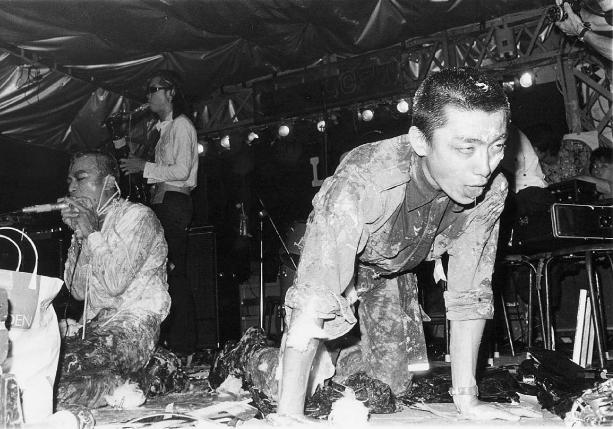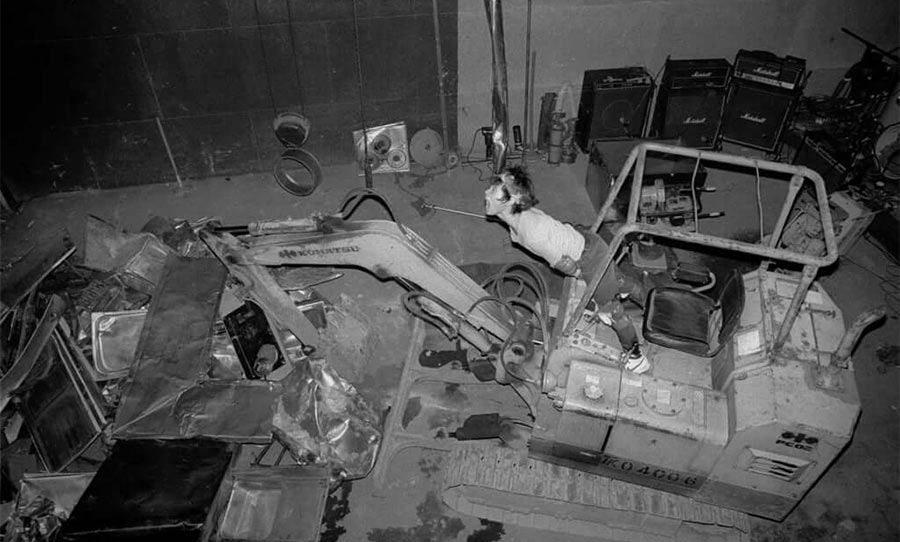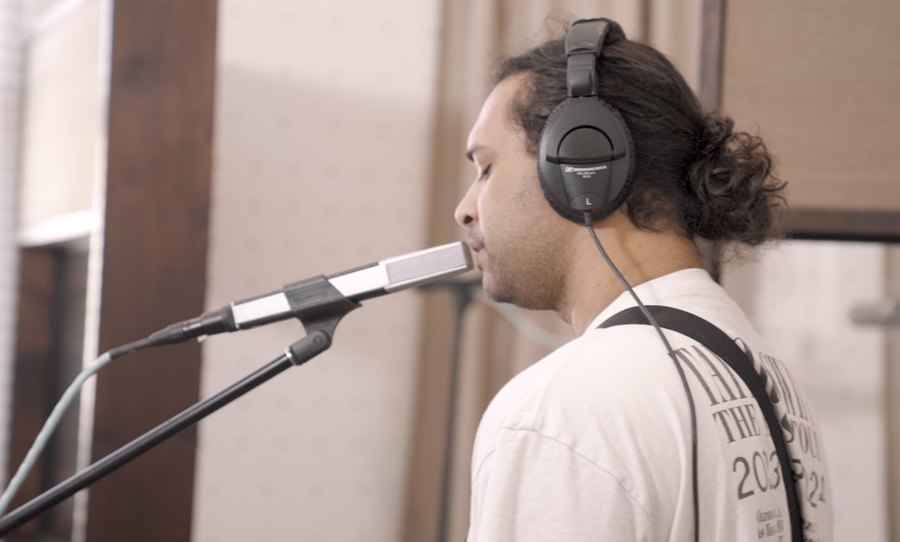We take a look at the Japanese noise (or “japanoise”) scene of the 20th Century, one of the most batshit music scenes to ever exist.
One thing music aficionados love to do is have pissing contests over who listens to the most avant-garde and unique bands; you listen to Turnstile? I raise you Death Grips. You listen to Death Grips? I raise you 100 Gecs. There’s no denying how fun it can be to expand your horizons and find the craziest and most boundary-pushing bands to challenge your preconceptions about music and impress your friends.
What if I told you then about a music scene where bands would demolish venues with excavators for their live performances? Or press 30 minutes of sounds from porn into a record and release it as a tribute album to a deeply respected late Japanese Emperor? Or perform live with just two members: one that screams and the other that masturbates? That music scene is real, and it’s japanoise.

Japanoise (or Japanese noise music) is a genre and subculture that originated in Japan in the 1980s. It’s characterized by its use of extreme noise, distortion, and experimental sounds, often being blatantly atonal and arhythmical. Japanoise artists often employ unconventional performance techniques, and the genre is known for its emphasis on energy, intensity, batshittery, and, oftentimes, its dangerous live performances.
Today, I’d like to explore the world of Japanoise by telling the story of four of its most significant, interesting, and influential bands, so without further ado, let’s begin.
Hijokaidan
Hijokaidan are the band that started it all. Originally a punk band by the name of Rasenkaidan (which translates to “spiral staircase”), the group took inspiration from the burgeoning industrial and avant-garde music scenes of the 70’s, incorporating the genres’ improvisational elements and harsh noises into their own music in an effort push punk to the extremes. By 1979, the band’s sound was so radically different from where they started that they opted to give themselves an entirely new name. Hijokaidan (“emergency staircase”) was born, and with it the japanoise scene.
Listening to Hijokadain’s 1982 debut album Zōroku no Kibyō is the best way to understand just how brutal, absurd and harsh the sounds of japanoise are. Following its intro track (the sounds of a man throwing up before being applauded), the record becomes an unrelenting cacophony of harsh noise from right to the finish, pushing the definition of what music to its breaking point.
If the band’s studio albums were extreme, then their live shows were nothing short of apocalyptic. Hijokaidan quickly gained a reputation in their home country for the physical and emotionally demanding nature of their performances, both for the band and the audience. The group would wreak chaos on stage, levelling equipment to rubble and littering the audience and venue with detritus and waste.
“We bought some earthworms and lugworms at a fishing tackle shop and mixed these in buckets with eggs, milk, squid, salmon roe, raw fish and so on. During the performance we upended these buckets over our heads.” Hijokaidan guitarist told The Wire of a particularly memorable 1982 show.
“There was also an incident where Ebi-kun, a devoted follower of Hijokaidan and pyromaniac, got so turned on by the performance that he threw a firecracker on to the stage.”
It was this batshittery, both of Hijokaidan’s studio recordings and live shows, that would set the standard for japanoise and inspire the iconic groups that would spring up into the ‘80s.
The Gerogerigegege
The Gerogerigegege are one such group to draw inspiration from Hijokaidan, and are one of the most interesting and storied groups to spring out of the scene, so much so, in fact, that to cover everything truly interesting about them would result in an entire book’s worth of content, so for today I’ll stick to a select few of their most interesting works and stories.
The Gerogerigegege’s lineup has consisted of many members over the years, but the two you need to know are founding members Juntaro Yamanouchi and Tetsuyah Endoh. Of the pair, the former is the band’s defacto leader and head musician, while the latter was the band’s appointed exhibitionist, whose sole job in the group was to masturbate on stage. This should tell you everything you need to know about how left field the Gerogerigegege are.
While they have created more traditional noise music in the style of Hijokaidan, The Gerogerigegege are perhaps best known for their incredible “covers” of popular Western music. These covers all follow the same format: Yamanouchi would scream the title of the song in a thick Japanese accent, count the band in with “one, two, three, four!” à la The Ramones, then they would all would make as much noise as they possibly could for 30 seconds or so. End of cover.
Another highlight from The Gerogerigegege’s vast discography is their record Showa from 1989. Created as a tribute to Japanese Emperor Shōwa who passed away in January of that year. The album begins with a minute of solemn, lo-fi orchestral music, before transitioning into 36 minutes of unedited sex sounds from pornographic films, and finally ending with another minute of the orchestral music to bookend the whole shebang.
The wildest part? The Gerogerigegege released the record to stores with no indication that it was anything but a legitimate tribute to the late monarch, so there’s a very real chance that a number of hapless grieving monarchists purchased it, only to discover what the album truly was at a later date. The Gerogerigegege wouldn’t have had it any other way.
Hanatarash
Let me set the scene: It’s 1985 and you’re at the Tokyo Superloft live music venue for a Hanatarash gig. Just as the performance is set to start, a Komatsu excavator comes crashing through the back wall of the building, writhing and screeching as it flattens the stage to rubble. As the dust begins to settle, a crazed man by the name of Yamata Eye emerges from the Komatsu’s cockpit in a berserker-like craze. He begins to fashion a Molotov cocktail amongst the rubble, eventually being subdued by the audience before he can light it and complete his arsonous mission. You’ve just experienced a Hanatarash gig.
Hanatarash are probably the most extreme japanoise band to ever exist, if not the most extreme band to ever exist. Formed in 1984 by Yamataka Eye and Mitsuru Tabata, Hanatarash had a simple mission: push music and performance art as far as they possibly could.
Their brand of noise music bears a lot of similarities with that of their forebearers Hijokaidon, but it was the live stage where Hanatarash really set themselves apart from their peers.
The band quickly gained a reputation as the most dangerous band to see live. Apart from the infamous “bulldozer” (or, rather, excavator) gig, there are also stories of Yamataka Eye throwing heavy objects like oil barrels around and operating heavy industrial tools while writhing around on stage, at one point almost amputating his own leg with a power saw strapped to his back. In one particularly gruesome account, Eye allegedly cut the corpse of a cat in half with a machete (or chainsaw, depending on which accounts you believe) and threw the viscera into the crowd.
As far as extreme bands go, it doesn’t get much more extreme than Hanatarash.
Boredoms
Of all the bands spoken of today, Boredoms are arguably the most musical of the bunch, though that isn’t saying much.
Started by Hanatarash’s infamous frontman Yamataka Eye, Boredoms transitioned away from the harsh noise of Eye’s former band to utilise much more traditional instrumentation, even committing the cardinal sin of japanoise by giving most of their tracks a steady beat and occasional melody (shock horror!). The result is a sound closer to an extreme version of funk and rock than noise, so it’s debatable whether they truly count as “japanoise”. Regardless, I opted to include them in this list thanks to their connection to Hanatarash and how interesting and engaging their art is.
While other japanoise groups specialise in making music that will cause you to lose your mind, Boredom sounds more like the band themselves losing their minds. While confronting to many, there’s also something strangely cathartic about witnessing Eye and his collaborators completely let go of their inhibitions, hacking away at their instruments and shrieking like animals.
One of the most interesting things about Boredoms is the traction they gained in the “mainstream”. The rise of grunge in the early ’90s saw major labels and promoters scrambling for subversive and raw acts, resulting in the band being signed to Warner records and supporting the likes of Sonic Youth and Nirvana on tour in the US.
Boredoms quickly became a favourite of Cobain, so much so that he requested they be added to the 1994 Lollapalooza music festival lineup as a condition for Nirvana signing on. Suffice it to say the band weren’t received particularly well by the USA’s festival audiences or stern critics, with the New York Times calling the band’s set “incorrigible noise”.
Boredoms still perform and release music to this day, writing on their official website that after “decades of noise, chaos, post-rock before there was such a thing, tribal Experimentation, remixing, trance-inducing feats of rhythmic intensity, lineup changes, Continued collaborations, and doing what they want regardless of trends and fashion, the Boredoms continue, and remain as vital as ever.”
The world of japanoise is expansive, and often shrouded in mystery and myth thanks to language barriers, the passing of time, and the elusive nature of the artists who pioneered the scene, but I hope that today I have given you at least a small taste of just what an incredible scene it truly was and is.
I leave you today with the liner notes from The Gerogerigegege’s album Instruments Disorder, which I believe perfectly encapsulates the spirit of japanoise; “Fuck compose. Fuck Melody. Dedicated to no one. Thanks to no one. ART IS OVER”



